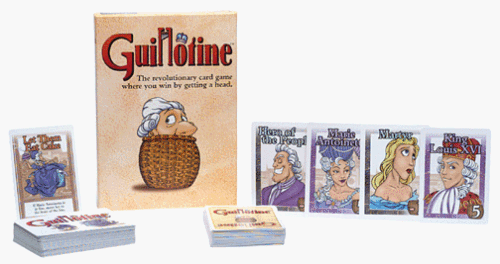During our recent trip to Singapore, Tobie and I finally picked up our copy of Guillotine, a rather cheeky card game that we had first played thanks to other gaming friends. A humorous game set around the time of the French revolution may not immediately seem like a good idea, but the resulting game was downright brilliant. Many thanks to our friends at Paradigm Infinitum for finally stocking a copy of this game.
Guillotine is one of those nicely simple games where the rules are easy enough to pick up however the strategy takes a bit more time. And a lot of the best games seem to be like that - the ones that are easily shared with new players and thus replay value becomes pretty high. And beyond that fact, it's a rather fun game as a whole with a clever pun in its tagline.
Guillotine is card game designed by Paul Peterson for Wizards of the Coast. It won the 1998 Origins Award for Best Traditional Game.
There are two decks in this game - the Nobles (50 cards) and the Action deck (60 cards). The game plays out across three "days" that start with 12 Noble cards being drawn from the deck and arranged in front of the Guillotine - a cardboard standee is provided to represent this. Players also have an initial hand of 5 Action cards that they keep in hand.
The basic turn order is simple enough - first a player may play an Action card from their hand. Then they "collect" the Noble at the front of the line. Finally they draw a replacement Action card from the deck. The basic goal of the game is to have the most points at the end of three days of executions - your points are determined by the values declared on Noble cards.
There are five types of Noble cards determined by color representing different factions lined up for execution. Royalty are purple. The military is red. The Church is blue. The civic members are green. And finally the grey faction consists of martyrs and other folks mistakenly lined up for execution as well. Typically there are benefits to focusing on a particular color of cards like how the military includes Palace Guards whose value is determined by the number of guards you have. In addition, the faction type also plays into which cards can be affected by certain Actions.
And this is where the strategy of the game really lies - in playing Actions. That one Action per turn can affect the line and determine which Noble you ultimately collect. Action cards can let you switch people around, move certain cards forward or even change how scores are computed entirely. The key is finding the best card to get the highest value noble to the front of the line so that you add a better score to your set.
Given the basic play order, it's easy enough to learn the game. But as things play out, you'll find that being limited to a single Action card per turn greatly affects how things will go. And the Actions of other players can leave you stuck with negative scoring gray nobles and all that fun stuff. And of course there's the usual bragging rights when you nab key figures like King Louis XVI or Marie Antoinette.
And some of the Action cards are pretty wild and do more than just move a particular Noble card up or down the line. Some cards dramatically change things such as reversing the entire line order. Beyond that though, some Nobles have their own special effects such as ending the execution day as a whole or jumping to the end of the line after an Action card is played. All these little variables come together for some rather dynamic game strategy as each of you try to "get a head" as the tagline states.
Guillotine is a lovely game which offers a lot of fun through rather cute little artwork. It's definitely a quaint little gateway game that should be easy to use to bring in new players to your game night and yet will remain a hit with experienced players. Thus I'm happy to rate this game as 4 Nobles trying to escape the chopping block out of a possible 5.

No comments:
Post a Comment